DSDM Agile Project Framework: Roles, Lifecycle, and Principles
VerifiedAdded on 2022/05/19
|20
|3331
|30
Report
AI Summary
The report provides a comprehensive overview of the DSDM Agile Project Framework, a dynamic system development method (DSDM) designed to support agile approaches. It details the framework's integration with Scrum, highlighting its strengths at the project level and simplifying Scrum's delivery teams. The report explores DSDM's principles, including focusing on business needs, timely delivery, collaboration, and uncompromising quality. It outlines the project lifecycle, encompassing pre-project population, fundamentals, development evolution, implementation, and post-project phases. Furthermore, the report defines key roles within the framework, such as the business sponsor, visionary, project manager, and technical coordinator, emphasizing their responsibilities and contributions to project success. The analysis also covers the framework's approach to project variables (time, cost, and quality), emphasizing the importance of adapting to changing business needs and maintaining a commitment to delivering value.
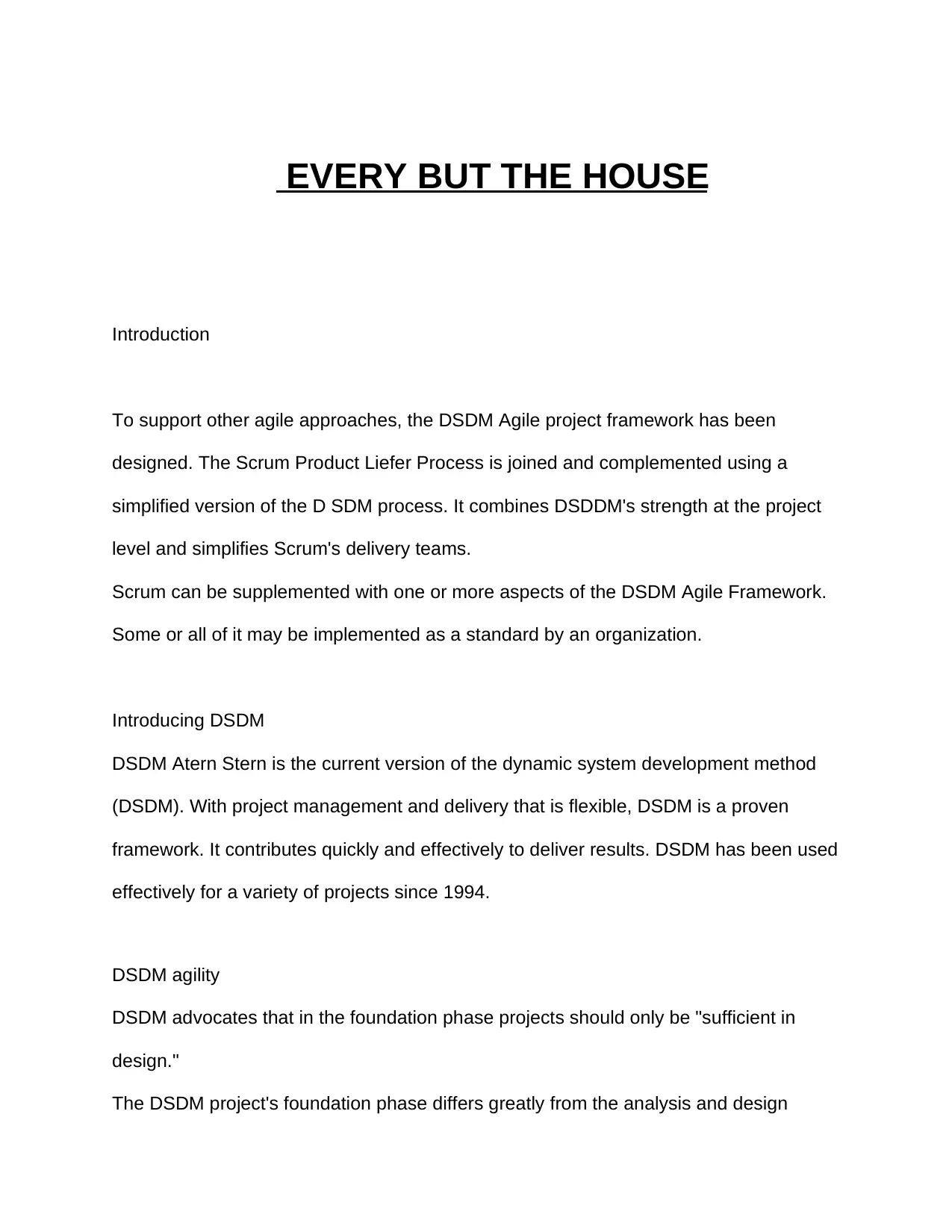
EVERY BUT THE HOUSE
Introduction
To support other agile approaches, the DSDM Agile project framework has been
designed. The Scrum Product Liefer Process is joined and complemented using a
simplified version of the D SDM process. It combines DSDDM's strength at the project
level and simplifies Scrum's delivery teams.
Scrum can be supplemented with one or more aspects of the DSDM Agile Framework.
Some or all of it may be implemented as a standard by an organization.
Introducing DSDM
DSDM Atern Stern is the current version of the dynamic system development method
(DSDM). With project management and delivery that is flexible, DSDM is a proven
framework. It contributes quickly and effectively to deliver results. DSDM has been used
effectively for a variety of projects since 1994.
DSDM agility
DSDM advocates that in the foundation phase projects should only be "sufficient in
design."
The DSDM project's foundation phase differs greatly from the analysis and design
Introduction
To support other agile approaches, the DSDM Agile project framework has been
designed. The Scrum Product Liefer Process is joined and complemented using a
simplified version of the D SDM process. It combines DSDDM's strength at the project
level and simplifies Scrum's delivery teams.
Scrum can be supplemented with one or more aspects of the DSDM Agile Framework.
Some or all of it may be implemented as a standard by an organization.
Introducing DSDM
DSDM Atern Stern is the current version of the dynamic system development method
(DSDM). With project management and delivery that is flexible, DSDM is a proven
framework. It contributes quickly and effectively to deliver results. DSDM has been used
effectively for a variety of projects since 1994.
DSDM agility
DSDM advocates that in the foundation phase projects should only be "sufficient in
design."
The DSDM project's foundation phase differs greatly from the analysis and design
Paraphrase This Document
Need a fresh take? Get an instant paraphrase of this document with our AI Paraphraser
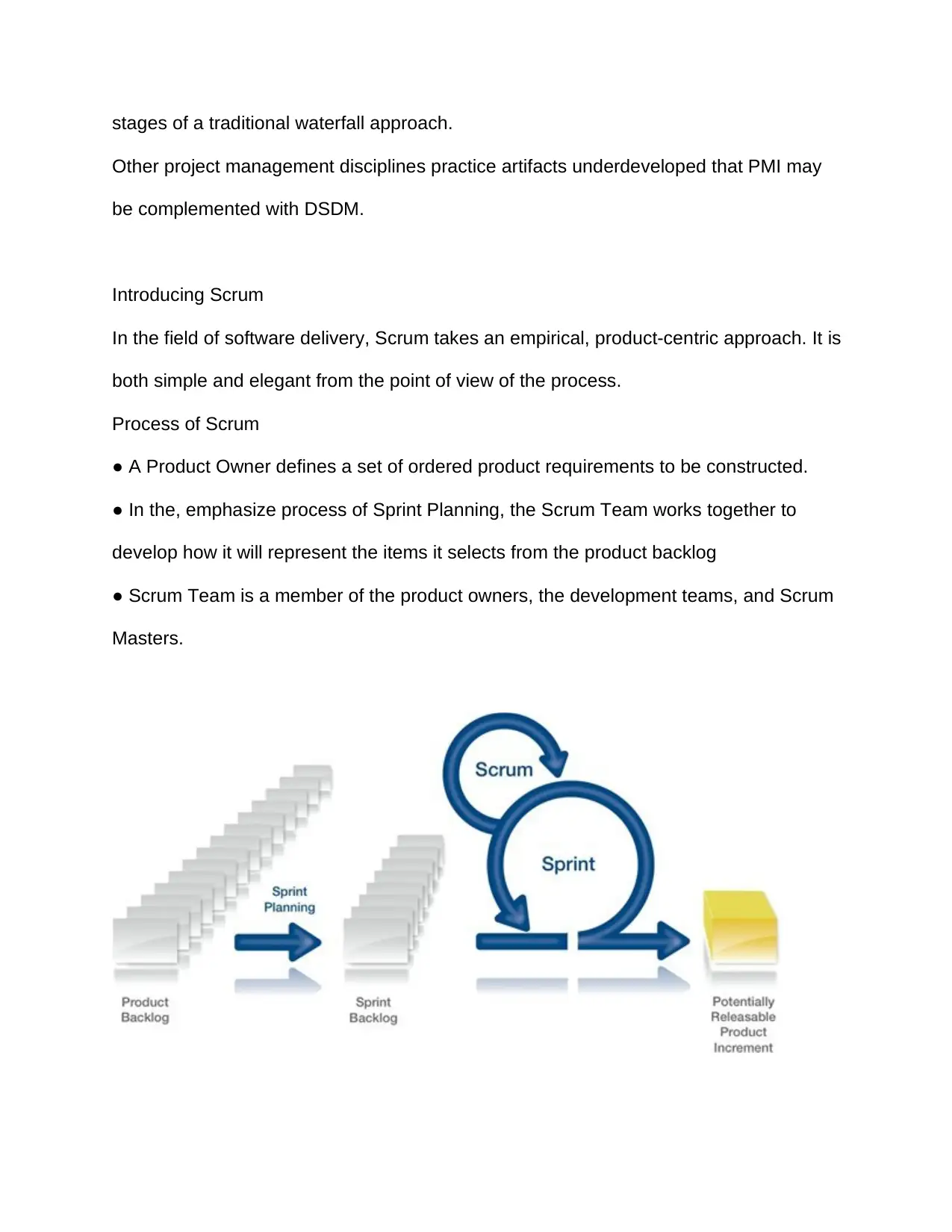
stages of a traditional waterfall approach.
Other project management disciplines practice artifacts underdeveloped that PMI may
be complemented with DSDM.
Introducing Scrum
In the field of software delivery, Scrum takes an empirical, product-centric approach. It is
both simple and elegant from the point of view of the process.
Process of Scrum
● A Product Owner defines a set of ordered product requirements to be constructed.
● In the, emphasize process of Sprint Planning, the Scrum Team works together to
develop how it will represent the items it selects from the product backlog
● Scrum Team is a member of the product owners, the development teams, and Scrum
Masters.
Other project management disciplines practice artifacts underdeveloped that PMI may
be complemented with DSDM.
Introducing Scrum
In the field of software delivery, Scrum takes an empirical, product-centric approach. It is
both simple and elegant from the point of view of the process.
Process of Scrum
● A Product Owner defines a set of ordered product requirements to be constructed.
● In the, emphasize process of Sprint Planning, the Scrum Team works together to
develop how it will represent the items it selects from the product backlog
● Scrum Team is a member of the product owners, the development teams, and Scrum
Masters.
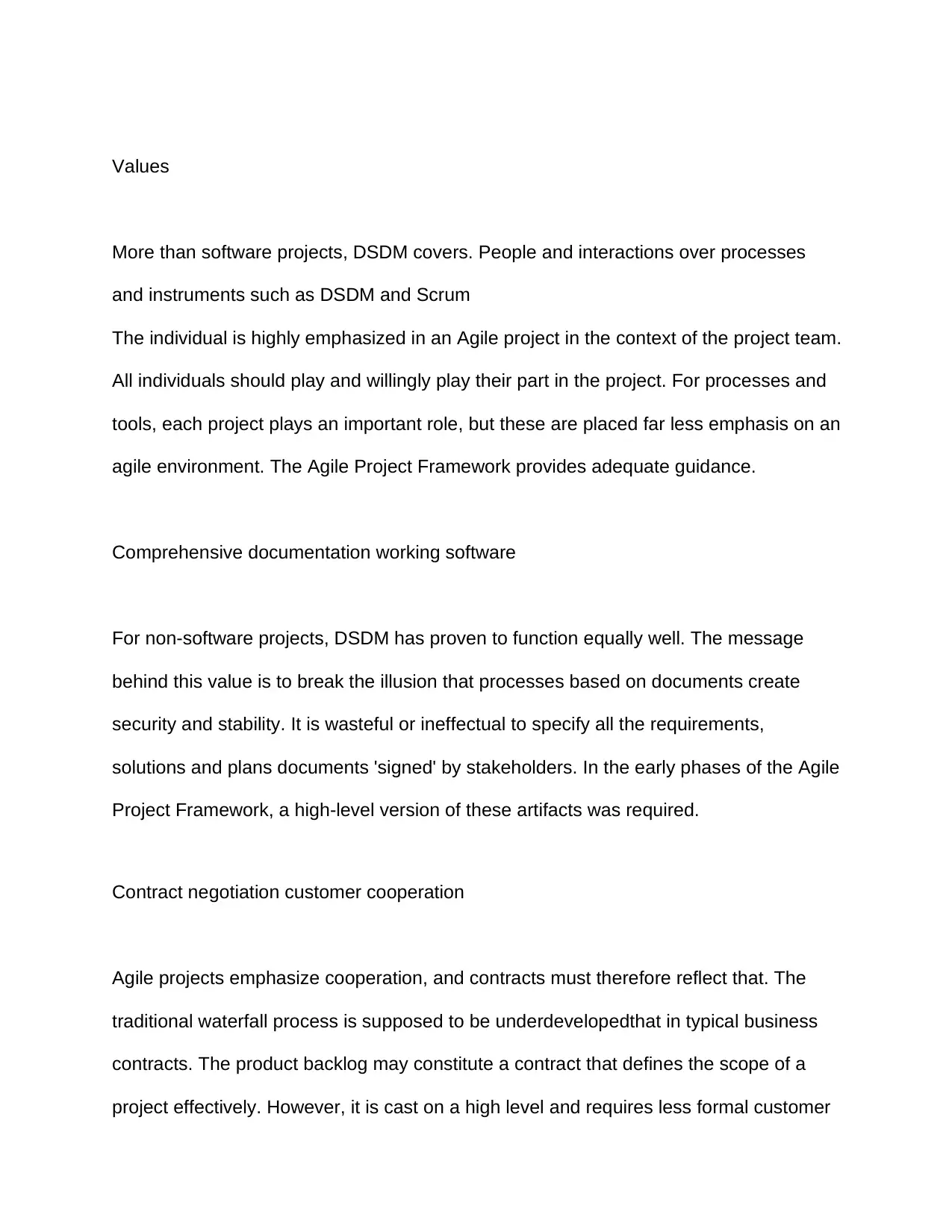
Values
More than software projects, DSDM covers. People and interactions over processes
and instruments such as DSDM and Scrum
The individual is highly emphasized in an Agile project in the context of the project team.
All individuals should play and willingly play their part in the project. For processes and
tools, each project plays an important role, but these are placed far less emphasis on an
agile environment. The Agile Project Framework provides adequate guidance.
Comprehensive documentation working software
For non-software projects, DSDM has proven to function equally well. The message
behind this value is to break the illusion that processes based on documents create
security and stability. It is wasteful or ineffectual to specify all the requirements,
solutions and plans documents 'signed' by stakeholders. In the early phases of the Agile
Project Framework, a high-level version of these artifacts was required.
Contract negotiation customer cooperation
Agile projects emphasize cooperation, and contracts must therefore reflect that. The
traditional waterfall process is supposed to be underdevelopedthat in typical business
contracts. The product backlog may constitute a contract that defines the scope of a
project effectively. However, it is cast on a high level and requires less formal customer
More than software projects, DSDM covers. People and interactions over processes
and instruments such as DSDM and Scrum
The individual is highly emphasized in an Agile project in the context of the project team.
All individuals should play and willingly play their part in the project. For processes and
tools, each project plays an important role, but these are placed far less emphasis on an
agile environment. The Agile Project Framework provides adequate guidance.
Comprehensive documentation working software
For non-software projects, DSDM has proven to function equally well. The message
behind this value is to break the illusion that processes based on documents create
security and stability. It is wasteful or ineffectual to specify all the requirements,
solutions and plans documents 'signed' by stakeholders. In the early phases of the Agile
Project Framework, a high-level version of these artifacts was required.
Contract negotiation customer cooperation
Agile projects emphasize cooperation, and contracts must therefore reflect that. The
traditional waterfall process is supposed to be underdevelopedthat in typical business
contracts. The product backlog may constitute a contract that defines the scope of a
project effectively. However, it is cast on a high level and requires less formal customer
⊘ This is a preview!⊘
Do you want full access?
Subscribe today to unlock all pages.

Trusted by 1+ million students worldwide
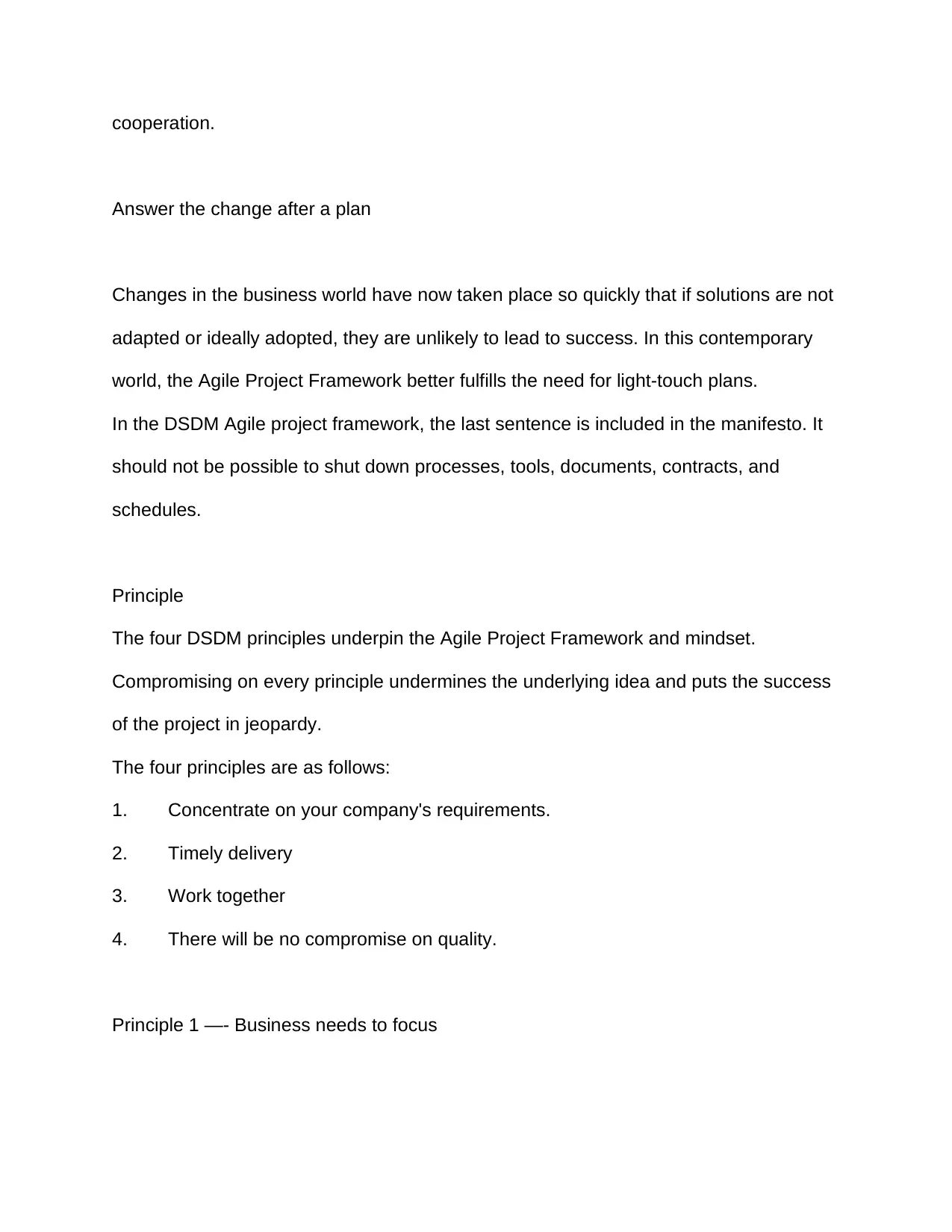
cooperation.
Answer the change after a plan
Changes in the business world have now taken place so quickly that if solutions are not
adapted or ideally adopted, they are unlikely to lead to success. In this contemporary
world, the Agile Project Framework better fulfills the need for light-touch plans.
In the DSDM Agile project framework, the last sentence is included in the manifesto. It
should not be possible to shut down processes, tools, documents, contracts, and
schedules.
Principle
The four DSDM principles underpin the Agile Project Framework and mindset.
Compromising on every principle undermines the underlying idea and puts the success
of the project in jeopardy.
The four principles are as follows:
1. Concentrate on your company's requirements.
2. Timely delivery
3. Work together
4. There will be no compromise on quality.
Principle 1 —- Business needs to focus
Answer the change after a plan
Changes in the business world have now taken place so quickly that if solutions are not
adapted or ideally adopted, they are unlikely to lead to success. In this contemporary
world, the Agile Project Framework better fulfills the need for light-touch plans.
In the DSDM Agile project framework, the last sentence is included in the manifesto. It
should not be possible to shut down processes, tools, documents, contracts, and
schedules.
Principle
The four DSDM principles underpin the Agile Project Framework and mindset.
Compromising on every principle undermines the underlying idea and puts the success
of the project in jeopardy.
The four principles are as follows:
1. Concentrate on your company's requirements.
2. Timely delivery
3. Work together
4. There will be no compromise on quality.
Principle 1 —- Business needs to focus
Paraphrase This Document
Need a fresh take? Get an instant paraphrase of this document with our AI Paraphraser
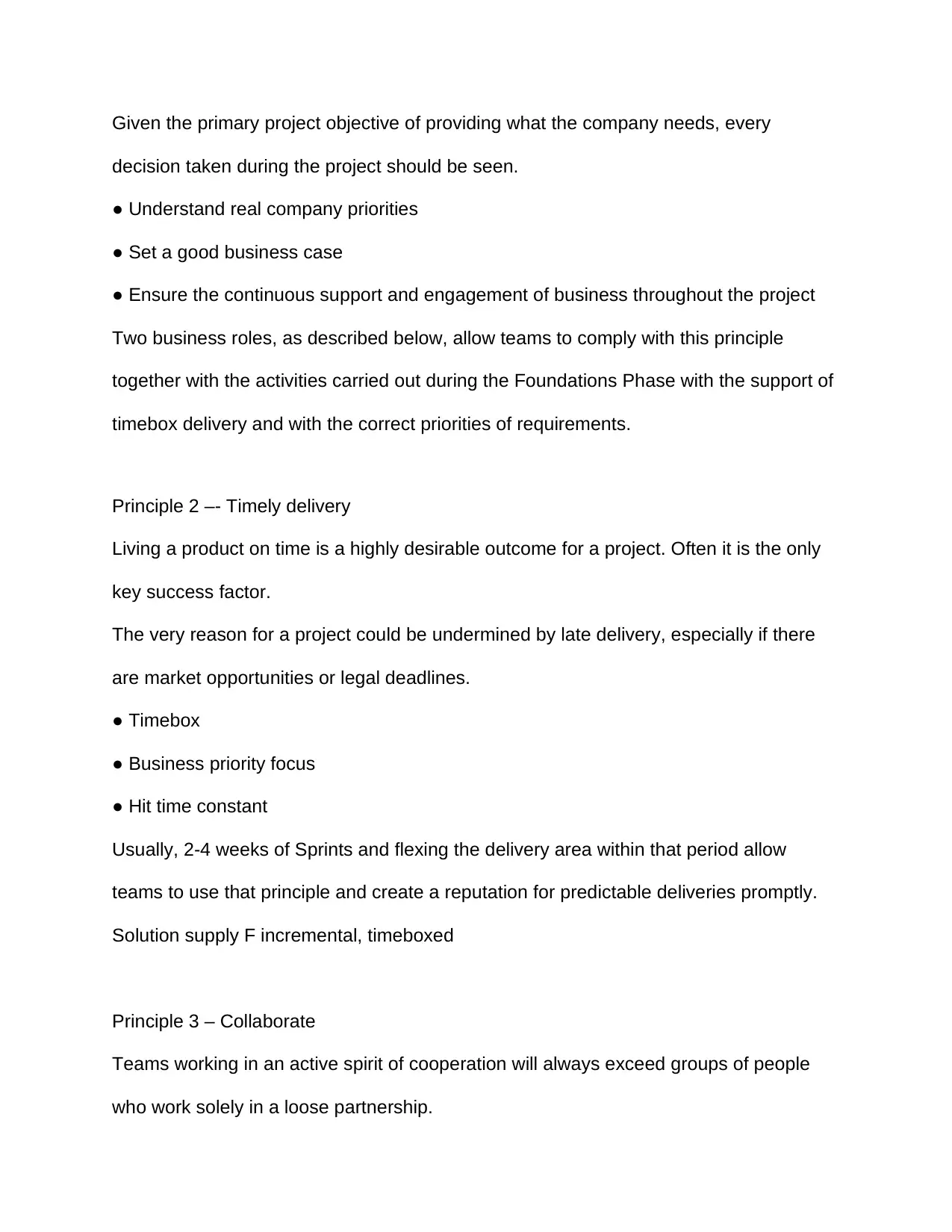
Given the primary project objective of providing what the company needs, every
decision taken during the project should be seen.
● Understand real company priorities
● Set a good business case
● Ensure the continuous support and engagement of business throughout the project
Two business roles, as described below, allow teams to comply with this principle
together with the activities carried out during the Foundations Phase with the support of
timebox delivery and with the correct priorities of requirements.
Principle 2 –‐ Timely delivery
Living a product on time is a highly desirable outcome for a project. Often it is the only
key success factor.
The very reason for a project could be undermined by late delivery, especially if there
are market opportunities or legal deadlines.
● Timebox
● Business priority focus
● Hit time constant
Usually, 2-4 weeks of Sprints and flexing the delivery area within that period allow
teams to use that principle and create a reputation for predictable deliveries promptly.
Solution supply F incremental, timeboxed
Principle 3 – Collaborate
Teams working in an active spirit of cooperation will always exceed groups of people
who work solely in a loose partnership.
decision taken during the project should be seen.
● Understand real company priorities
● Set a good business case
● Ensure the continuous support and engagement of business throughout the project
Two business roles, as described below, allow teams to comply with this principle
together with the activities carried out during the Foundations Phase with the support of
timebox delivery and with the correct priorities of requirements.
Principle 2 –‐ Timely delivery
Living a product on time is a highly desirable outcome for a project. Often it is the only
key success factor.
The very reason for a project could be undermined by late delivery, especially if there
are market opportunities or legal deadlines.
● Timebox
● Business priority focus
● Hit time constant
Usually, 2-4 weeks of Sprints and flexing the delivery area within that period allow
teams to use that principle and create a reputation for predictable deliveries promptly.
Solution supply F incremental, timeboxed
Principle 3 – Collaborate
Teams working in an active spirit of cooperation will always exceed groups of people
who work solely in a loose partnership.
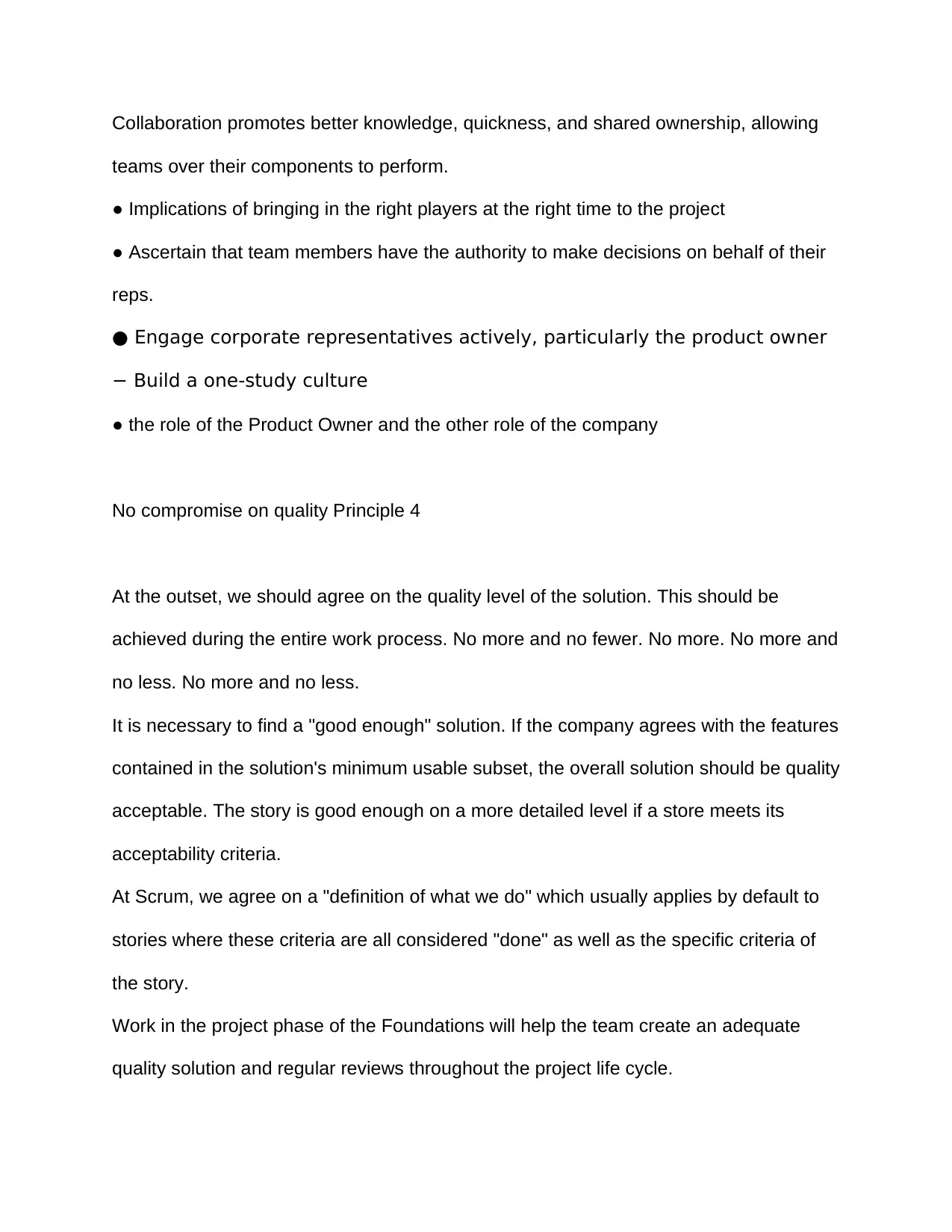
Collaboration promotes better knowledge, quickness, and shared ownership, allowing
teams over their components to perform.
● Implications of bringing in the right players at the right time to the project
● Ascertain that team members have the authority to make decisions on behalf of their
reps.
● Engage corporate representatives actively, particularly the product owner
− Build a one-study culture
● the role of the Product Owner and the other role of the company
No compromise on quality Principle 4
At the outset, we should agree on the quality level of the solution. This should be
achieved during the entire work process. No more and no fewer. No more. No more and
no less. No more and no less.
It is necessary to find a "good enough" solution. If the company agrees with the features
contained in the solution's minimum usable subset, the overall solution should be quality
acceptable. The story is good enough on a more detailed level if a store meets its
acceptability criteria.
At Scrum, we agree on a "definition of what we do" which usually applies by default to
stories where these criteria are all considered "done" as well as the specific criteria of
the story.
Work in the project phase of the Foundations will help the team create an adequate
quality solution and regular reviews throughout the project life cycle.
teams over their components to perform.
● Implications of bringing in the right players at the right time to the project
● Ascertain that team members have the authority to make decisions on behalf of their
reps.
● Engage corporate representatives actively, particularly the product owner
− Build a one-study culture
● the role of the Product Owner and the other role of the company
No compromise on quality Principle 4
At the outset, we should agree on the quality level of the solution. This should be
achieved during the entire work process. No more and no fewer. No more. No more and
no less. No more and no less.
It is necessary to find a "good enough" solution. If the company agrees with the features
contained in the solution's minimum usable subset, the overall solution should be quality
acceptable. The story is good enough on a more detailed level if a store meets its
acceptability criteria.
At Scrum, we agree on a "definition of what we do" which usually applies by default to
stories where these criteria are all considered "done" as well as the specific criteria of
the story.
Work in the project phase of the Foundations will help the team create an adequate
quality solution and regular reviews throughout the project life cycle.
⊘ This is a preview!⊘
Do you want full access?
Subscribe today to unlock all pages.

Trusted by 1+ million students worldwide
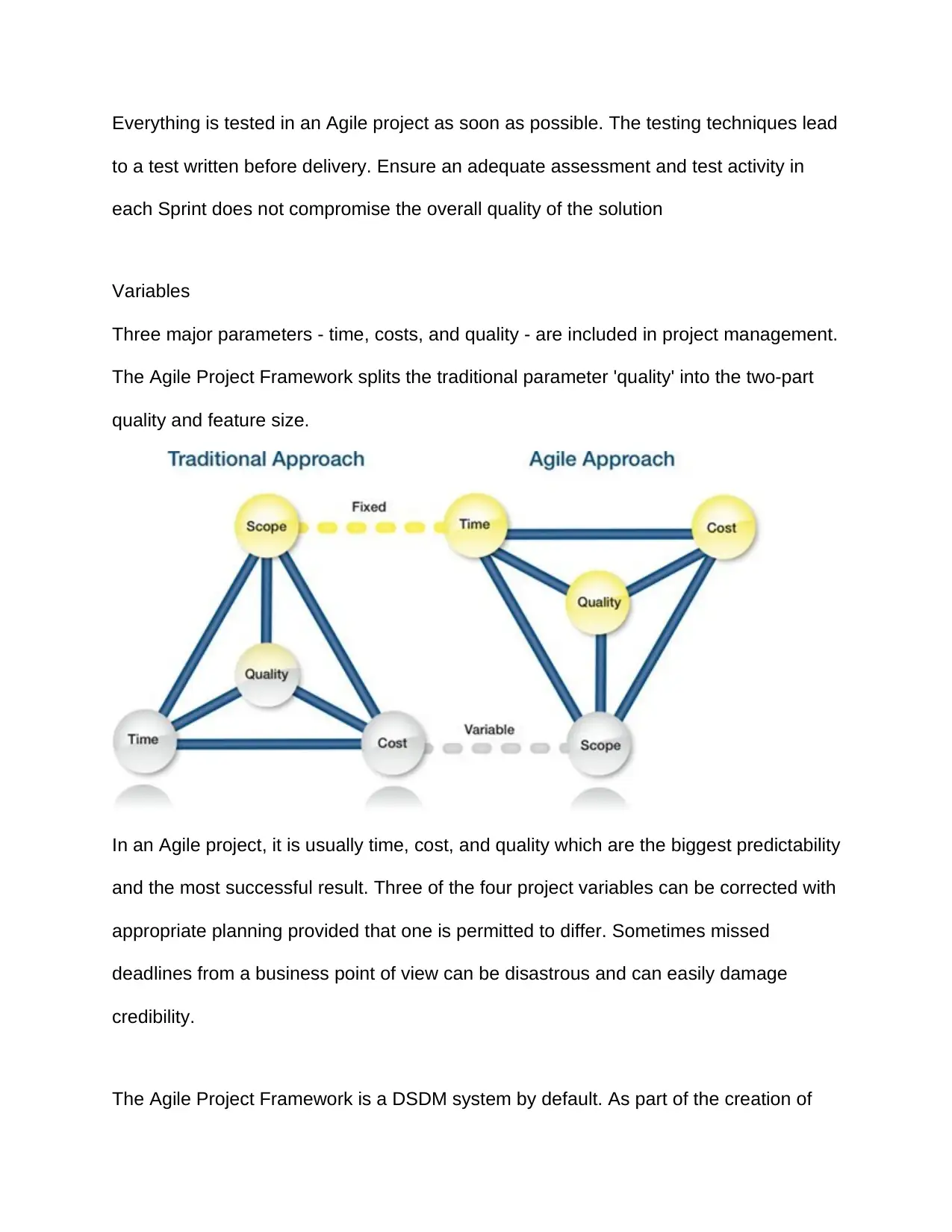
Everything is tested in an Agile project as soon as possible. The testing techniques lead
to a test written before delivery. Ensure an adequate assessment and test activity in
each Sprint does not compromise the overall quality of the solution
Variables
Three major parameters - time, costs, and quality - are included in project management.
The Agile Project Framework splits the traditional parameter 'quality' into the two-part
quality and feature size.
In an Agile project, it is usually time, cost, and quality which are the biggest predictability
and the most successful result. Three of the four project variables can be corrected with
appropriate planning provided that one is permitted to differ. Sometimes missed
deadlines from a business point of view can be disastrous and can easily damage
credibility.
The Agile Project Framework is a DSDM system by default. As part of the creation of
to a test written before delivery. Ensure an adequate assessment and test activity in
each Sprint does not compromise the overall quality of the solution
Variables
Three major parameters - time, costs, and quality - are included in project management.
The Agile Project Framework splits the traditional parameter 'quality' into the two-part
quality and feature size.
In an Agile project, it is usually time, cost, and quality which are the biggest predictability
and the most successful result. Three of the four project variables can be corrected with
appropriate planning provided that one is permitted to differ. Sometimes missed
deadlines from a business point of view can be disastrous and can easily damage
credibility.
The Agile Project Framework is a DSDM system by default. As part of the creation of
Paraphrase This Document
Need a fresh take? Get an instant paraphrase of this document with our AI Paraphraser
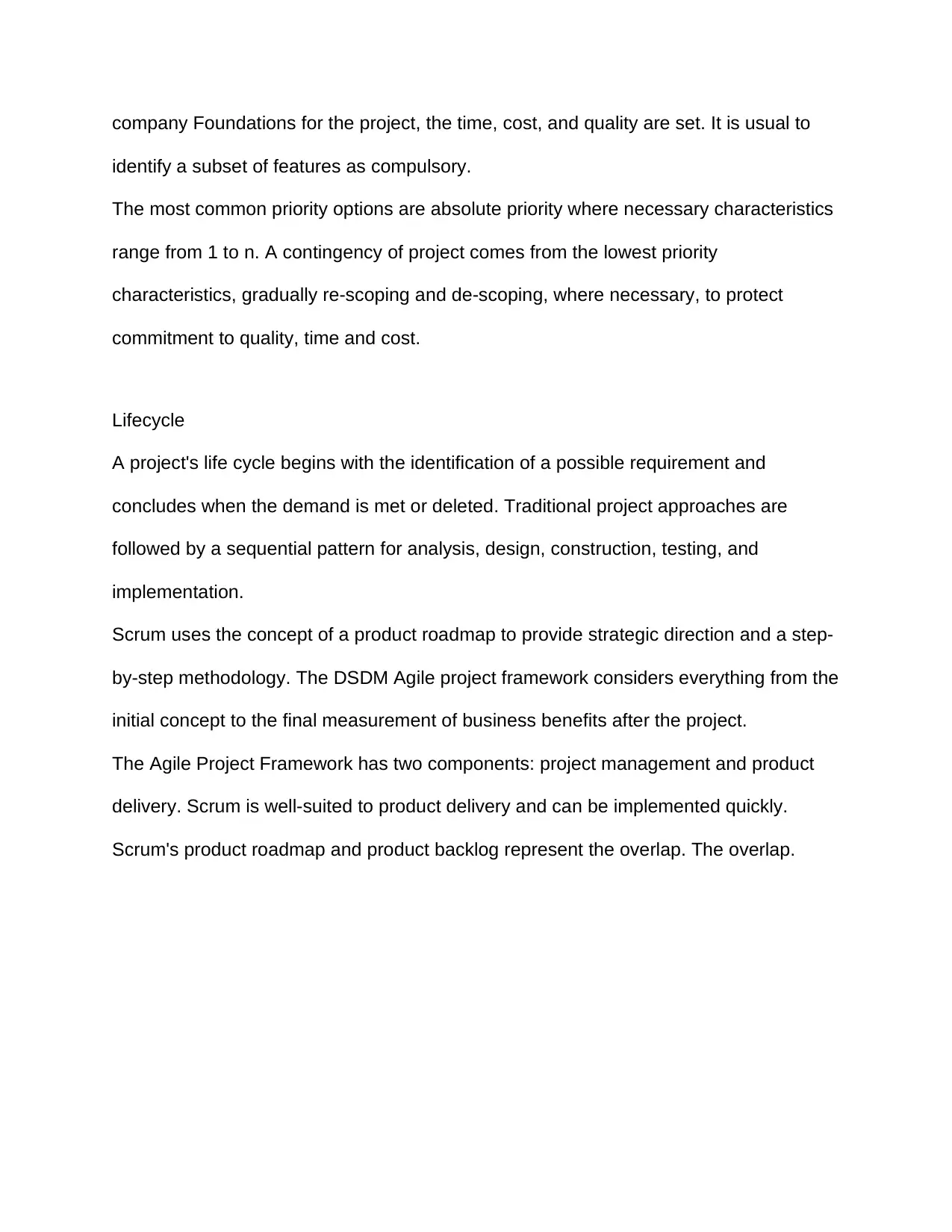
company Foundations for the project, the time, cost, and quality are set. It is usual to
identify a subset of features as compulsory.
The most common priority options are absolute priority where necessary characteristics
range from 1 to n. A contingency of project comes from the lowest priority
characteristics, gradually re-scoping and de-scoping, where necessary, to protect
commitment to quality, time and cost.
Lifecycle
A project's life cycle begins with the identification of a possible requirement and
concludes when the demand is met or deleted. Traditional project approaches are
followed by a sequential pattern for analysis, design, construction, testing, and
implementation.
Scrum uses the concept of a product roadmap to provide strategic direction and a step-
by-step methodology. The DSDM Agile project framework considers everything from the
initial concept to the final measurement of business benefits after the project.
The Agile Project Framework has two components: project management and product
delivery. Scrum is well-suited to product delivery and can be implemented quickly.
Scrum's product roadmap and product backlog represent the overlap. The overlap.
identify a subset of features as compulsory.
The most common priority options are absolute priority where necessary characteristics
range from 1 to n. A contingency of project comes from the lowest priority
characteristics, gradually re-scoping and de-scoping, where necessary, to protect
commitment to quality, time and cost.
Lifecycle
A project's life cycle begins with the identification of a possible requirement and
concludes when the demand is met or deleted. Traditional project approaches are
followed by a sequential pattern for analysis, design, construction, testing, and
implementation.
Scrum uses the concept of a product roadmap to provide strategic direction and a step-
by-step methodology. The DSDM Agile project framework considers everything from the
initial concept to the final measurement of business benefits after the project.
The Agile Project Framework has two components: project management and product
delivery. Scrum is well-suited to product delivery and can be implemented quickly.
Scrum's product roadmap and product backlog represent the overlap. The overlap.
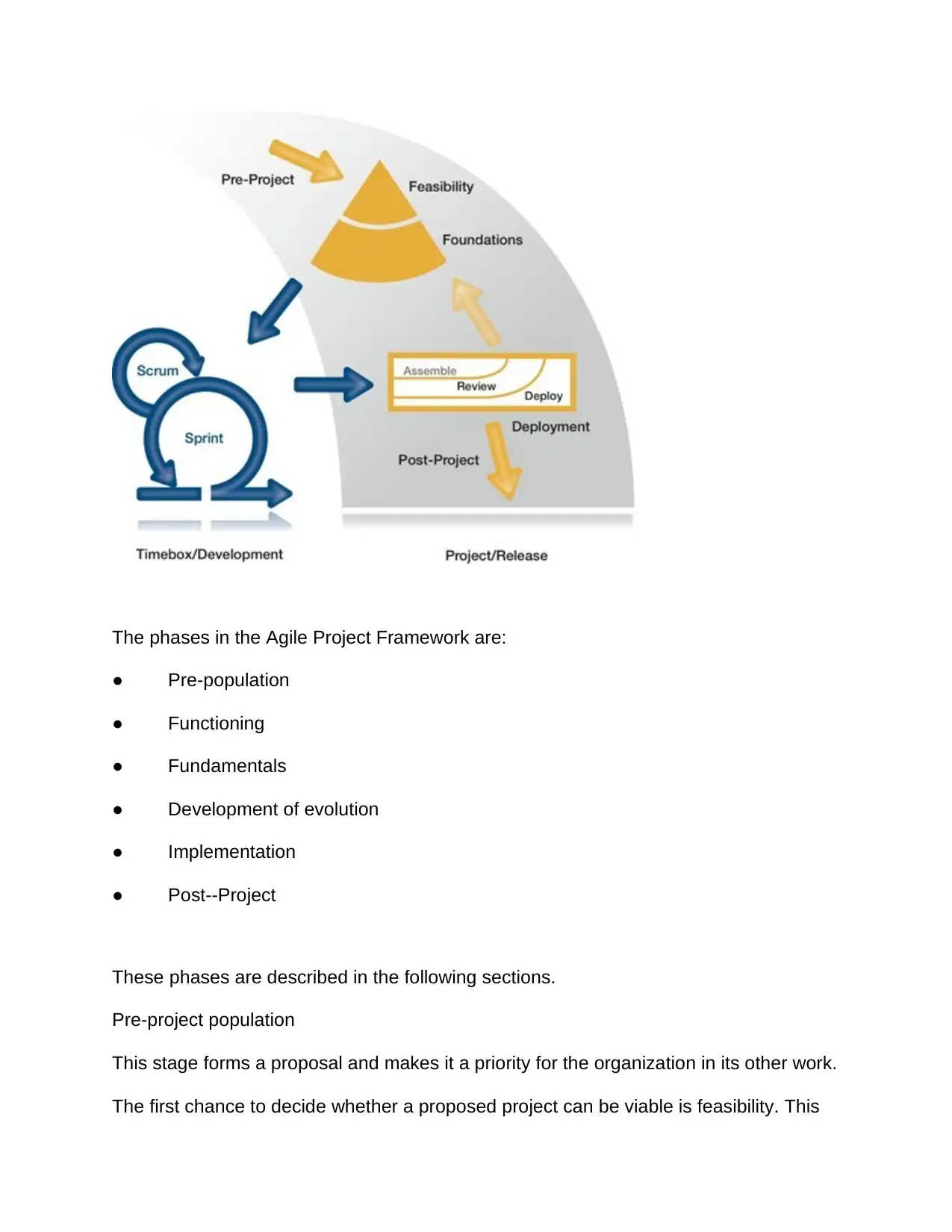
The phases in the Agile Project Framework are:
● Pre-population
● Functioning
● Fundamentals
● Development of evolution
● Implementation
● Post-‐Project
These phases are described in the following sections.
Pre-project population
This stage forms a proposal and makes it a priority for the organization in its other work.
The first chance to decide whether a proposed project can be viable is feasibility. This
● Pre-population
● Functioning
● Fundamentals
● Development of evolution
● Implementation
● Post-‐Project
These phases are described in the following sections.
Pre-project population
This stage forms a proposal and makes it a priority for the organization in its other work.
The first chance to decide whether a proposed project can be viable is feasibility. This
⊘ This is a preview!⊘
Do you want full access?
Subscribe today to unlock all pages.

Trusted by 1+ million students worldwide
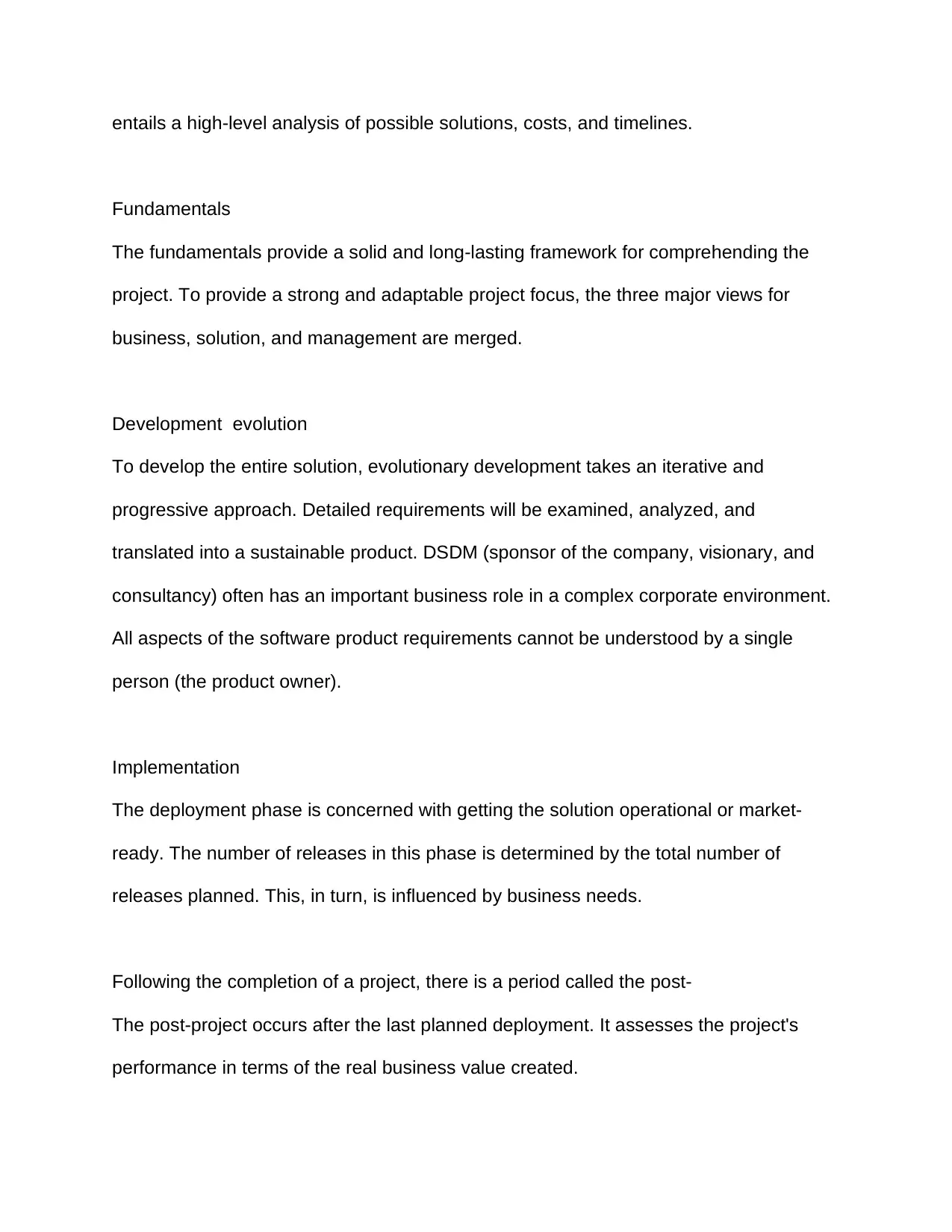
entails a high-level analysis of possible solutions, costs, and timelines.
Fundamentals
The fundamentals provide a solid and long-lasting framework for comprehending the
project. To provide a strong and adaptable project focus, the three major views for
business, solution, and management are merged.
Development evolution
To develop the entire solution, evolutionary development takes an iterative and
progressive approach. Detailed requirements will be examined, analyzed, and
translated into a sustainable product. DSDM (sponsor of the company, visionary, and
consultancy) often has an important business role in a complex corporate environment.
All aspects of the software product requirements cannot be understood by a single
person (the product owner).
Implementation
The deployment phase is concerned with getting the solution operational or market-
ready. The number of releases in this phase is determined by the total number of
releases planned. This, in turn, is influenced by business needs.
Following the completion of a project, there is a period called the post-
The post-project occurs after the last planned deployment. It assesses the project's
performance in terms of the real business value created.
Fundamentals
The fundamentals provide a solid and long-lasting framework for comprehending the
project. To provide a strong and adaptable project focus, the three major views for
business, solution, and management are merged.
Development evolution
To develop the entire solution, evolutionary development takes an iterative and
progressive approach. Detailed requirements will be examined, analyzed, and
translated into a sustainable product. DSDM (sponsor of the company, visionary, and
consultancy) often has an important business role in a complex corporate environment.
All aspects of the software product requirements cannot be understood by a single
person (the product owner).
Implementation
The deployment phase is concerned with getting the solution operational or market-
ready. The number of releases in this phase is determined by the total number of
releases planned. This, in turn, is influenced by business needs.
Following the completion of a project, there is a period called the post-
The post-project occurs after the last planned deployment. It assesses the project's
performance in terms of the real business value created.
Paraphrase This Document
Need a fresh take? Get an instant paraphrase of this document with our AI Paraphraser
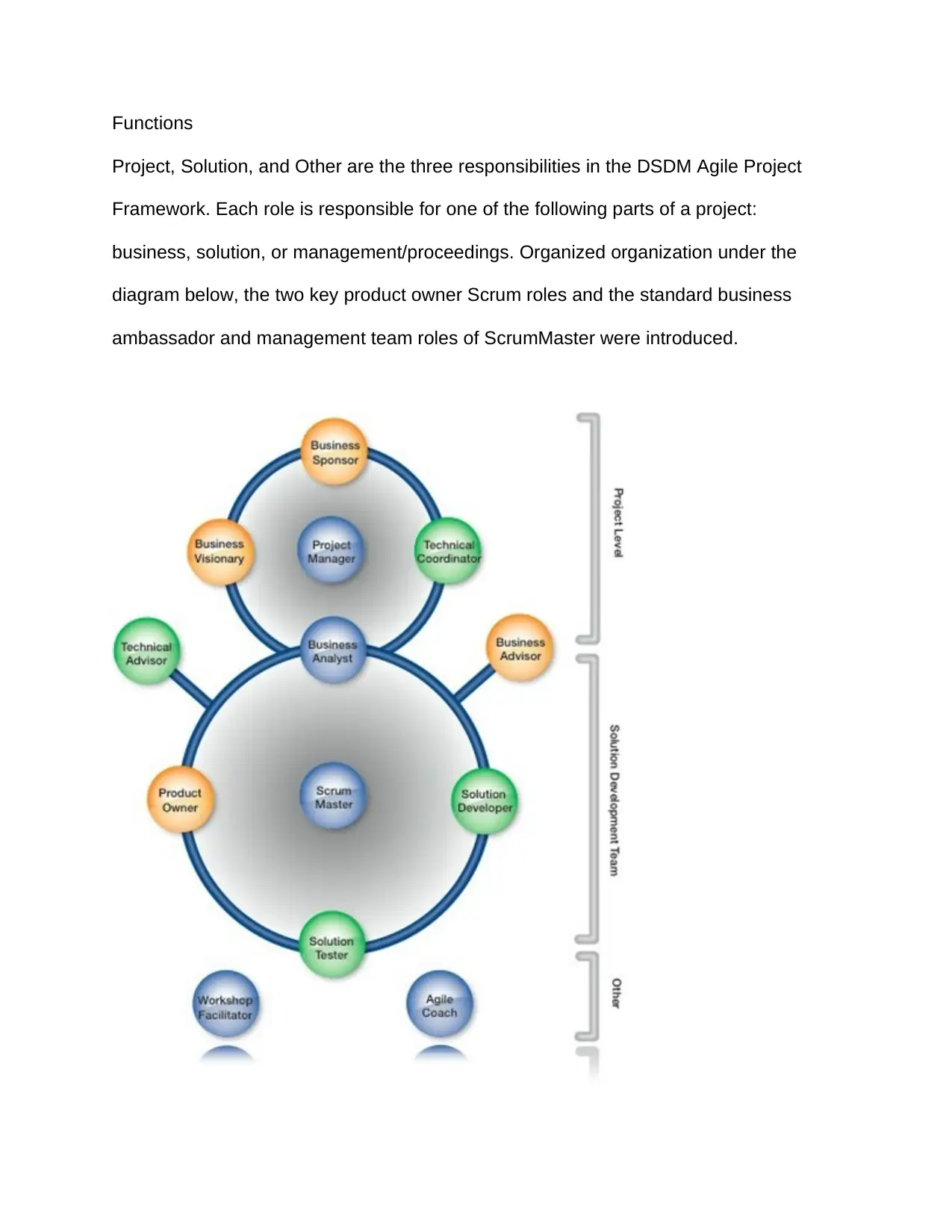
Functions
Project, Solution, and Other are the three responsibilities in the DSDM Agile Project
Framework. Each role is responsible for one of the following parts of a project:
business, solution, or management/proceedings. Organized organization under the
diagram below, the two key product owner Scrum roles and the standard business
ambassador and management team roles of ScrumMaster were introduced.
Project, Solution, and Other are the three responsibilities in the DSDM Agile Project
Framework. Each role is responsible for one of the following parts of a project:
business, solution, or management/proceedings. Organized organization under the
diagram below, the two key product owner Scrum roles and the standard business
ambassador and management team roles of ScrumMaster were introduced.
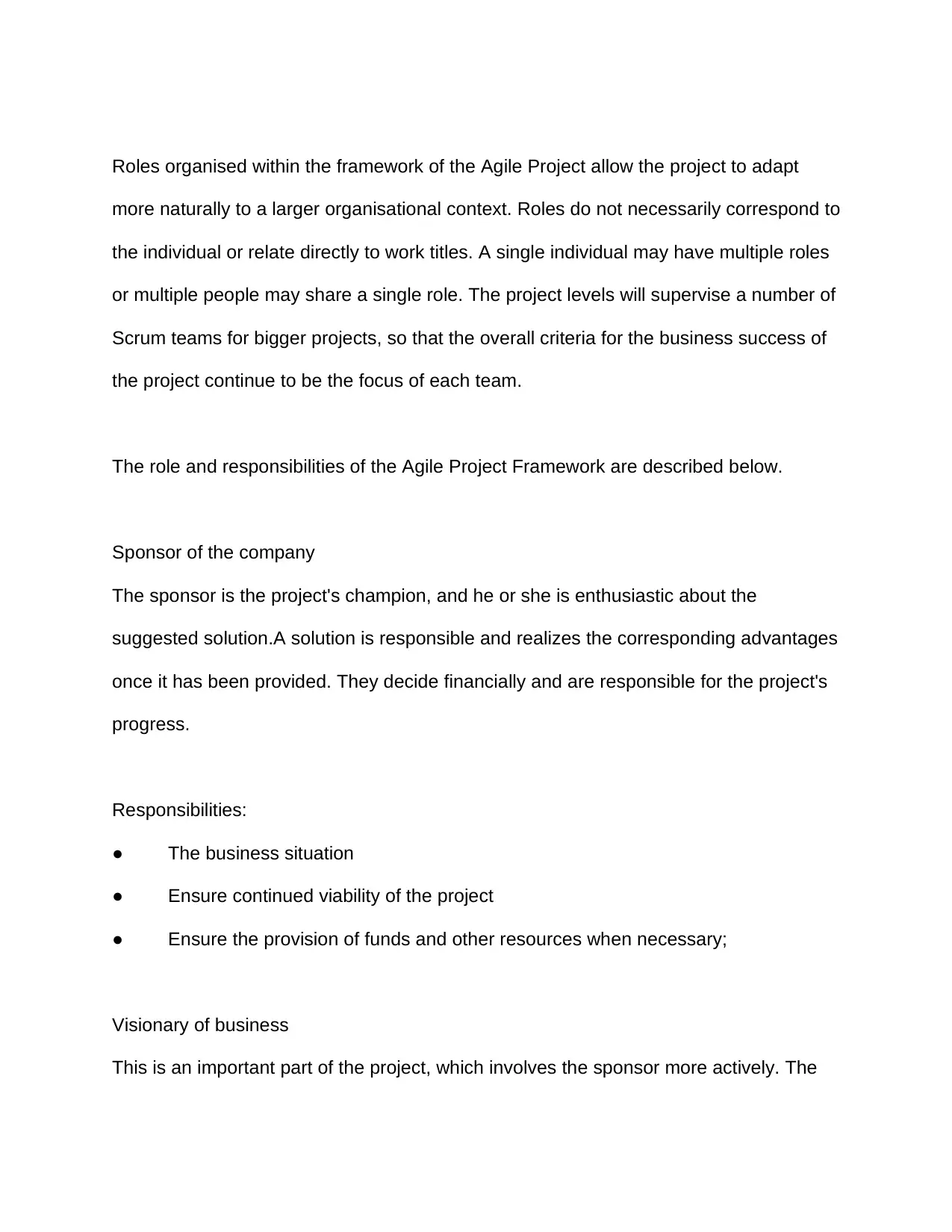
Roles organised within the framework of the Agile Project allow the project to adapt
more naturally to a larger organisational context. Roles do not necessarily correspond to
the individual or relate directly to work titles. A single individual may have multiple roles
or multiple people may share a single role. The project levels will supervise a number of
Scrum teams for bigger projects, so that the overall criteria for the business success of
the project continue to be the focus of each team.
The role and responsibilities of the Agile Project Framework are described below.
Sponsor of the company
The sponsor is the project's champion, and he or she is enthusiastic about the
suggested solution.A solution is responsible and realizes the corresponding advantages
once it has been provided. They decide financially and are responsible for the project's
progress.
Responsibilities:
● The business situation
● Ensure continued viability of the project
● Ensure the provision of funds and other resources when necessary;
Visionary of business
This is an important part of the project, which involves the sponsor more actively. The
more naturally to a larger organisational context. Roles do not necessarily correspond to
the individual or relate directly to work titles. A single individual may have multiple roles
or multiple people may share a single role. The project levels will supervise a number of
Scrum teams for bigger projects, so that the overall criteria for the business success of
the project continue to be the focus of each team.
The role and responsibilities of the Agile Project Framework are described below.
Sponsor of the company
The sponsor is the project's champion, and he or she is enthusiastic about the
suggested solution.A solution is responsible and realizes the corresponding advantages
once it has been provided. They decide financially and are responsible for the project's
progress.
Responsibilities:
● The business situation
● Ensure continued viability of the project
● Ensure the provision of funds and other resources when necessary;
Visionary of business
This is an important part of the project, which involves the sponsor more actively. The
⊘ This is a preview!⊘
Do you want full access?
Subscribe today to unlock all pages.

Trusted by 1+ million students worldwide
1 out of 20
Related Documents
Your All-in-One AI-Powered Toolkit for Academic Success.
+13062052269
info@desklib.com
Available 24*7 on WhatsApp / Email
![[object Object]](/_next/static/media/star-bottom.7253800d.svg)
Unlock your academic potential
Copyright © 2020–2025 A2Z Services. All Rights Reserved. Developed and managed by ZUCOL.





